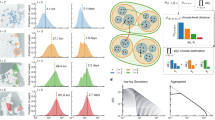Abstract
The application of the log-linear model to frequency counts has rekindled interest in the traditional social mobility table. This recent literature is to a degree divided over several issues, including how to develop an acceptable model of mobility flows and how to choose between near-equivalent models which generate almost identical fitted counts but have different substantive implications. In reviewing some of these issues, we draw upon Goldthorpe's development of Hauser's “levels” model and present a general mobility model which, we argue on theoretical grounds, should be broadly applicable to modern industrial societies. We develop the model using Australian data, extend it to British and American mobility data, and use Monte Carlo methods to choose between alternative models. In developing our substantive interpretations of different models, we illustrate models that underfit, overfit, and adequately fit the observed mobility flows.
Similar content being viewed by others
References
Atkinson, A.C. (1981). “Robustness, transformations and two graphical displays for outlying and influential observations in regression”, Biometrika 68: 13–20.
Broom, L., Duncan-Jones, P., Jones, F.L. & McDonnell, P. (1977). Investigating Social Mobility. Department of Sociology, Research School of Social Sciences, the Australian National University (Department Monograph No 1.)
Broom, L., Jones, F.L., McDonnell, P. & Williams, T. (1980). The Inheritance of Inequality. London: Routledge & Kegan Paul.
Bourdieu, P. (1977). “Cultural reproduction and social reproduction”, pp. 487–511 in J., Karabel & A. H. Halsey (eds), Power and Ideology in Education. New York: Oxford University Press.
Davis, P. (1984). Social Mobility and Class Structure in Australia and New Zealand. Paper presented to Section 27 of the Australian and New Zealand Association for the Advancement of Science, May 1984.
Duncan, O.D. (1981). “How destination depends on origin in the occupational mobility table”, American Journal of Sociology 84: 793–804.
Erikson, R. & Goldthorpe, J.H. (1985). “Are American rates of social mobility exceptionally high? New evidence on an old issue”, European Sociological Review 1: 1–28.
Erikson, R. & Portacarero, L. (1979). “Intergenerational class mobility in three Western European societies: England, France and Sweden”, British Journal of Sociology 30: 415–41.
Erikson, R. (1982). “Social fluidity in industrial nations”, British Journal of Sociology 33: 1–34.
Featherman, D. & Hauser, R.M. (1978) Opportunity and Change. New York: Academic Press.
Goldthorpe, J.H. (1980). Social Mobility and Class Structure in Modern Britain. Oxford: Clarendon Press (in collaboration with Catriona Llewellyn and Clive Payne).
Goodman, L.A. (1979). “Multiplicative models for the analysis of occupational mobility tables and other kinds of cross-classification tables”, American Journal of Sociology 84: 804–19.
Gruen, F.H. (1965). “Rural Australia”, pp. 253–73 in A.F., Davies & S., Encel (eds), Australian Society: A Sociological Introduction. Melbourne: Chesire.
Hauser, R.M. (1978). “A structural model of the mobility table”, Social Forces 56: 919–53.
Hauser, R.M. (1980). “Some exploratory methods for modelling mobility tables and other crossclassified data”, pp. 413–58 in Schuessler, K.F. (Ed.), Sociological Methodology 1980. San Francisco: Jossey-Bass.
Hauser, R.M. (1981). “Hope for the mobility ratio”, Social Forces 60: 544–56.
Hope, K. (1984). “Intergenerational and career mobility in Britain: an integrated analysis”, Social Science Research 13: 20–37.
Hout, M. (1983). Mobility Tables. Beverly Hills: Sage (No. 31 in Quantitative Applications in the Social Sciences).
Hout, M. (1984). “Status, autonomy, and training in occupational mobility”, American Journal of Sociology 89: 1379–1409.
Jones, F.L. (1985). “New and (very) old mobility ratios: Is there life after Benini”. Social Forces 63: 838–50.
Jones, F.L. & Davis, P. (1986). Models of Society: Class, Stratification and Gender in Australia and New Zealand. Sydney: Croom Helm.
Logan, J.A. (1983). “A multivariate model for mobility tables”, American Journal of Sociology 89: 324–49.
Macdonald, K. (1981). “On the formulation of a structural model of the mobility table”, Social Forces 60: 557–71.
Macdonald, K. (1983). “On the interpretation of a structural model of the mobility table”, Quality & Quantity 17: 203–24.
McCullagh, P. & Nelder, J.A. (1983). Generalized Linear Models. London: Chapman and Hall.
Pontinen, S. (1982). “Models and social mobility research: a comparison of some log-linear models of a social mobility matrix”, Quality & Quantity 16: 91–107.
Raftery, A.E. (1986). “Choosing models for cross-classifications”, American Sociological Review 51: 145–6.
Williams, D.A. (1984). “Residuals in generalized linear models”, pp. 59–68 in the Invited Papers, Proceedings of the XIIth International Biometric Conference. Tokyo.
Yamaguchi, K. (1982). “The structure of intergenerational occupational mobility: generality and specificity in resources, channels, and barriers”, American Journal of Sociology 88: 718–45.
Zubrzycki, J. (1969). “Migrants and the occupational structure”, pp. 31–44 in Throssel, H. (ed.), Ethnic Minorities in Australia: The Welfare of Aborigines and Migrants. Sydney: Australian Council of Social Services.
Author information
Authors and Affiliations
Rights and permissions
About this article
Cite this article
Jones, F.L., Wilson, S.R. & Pittelkow, Y. Modelling mobility: the use of simulation to choose between near-equivalent models. Qual Quant 24, 189–212 (1990). https://doi.org/10.1007/BF00209551
Issue Date:
DOI: https://doi.org/10.1007/BF00209551




